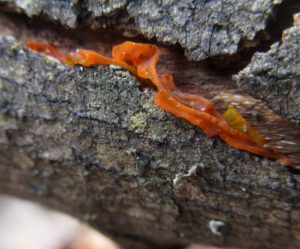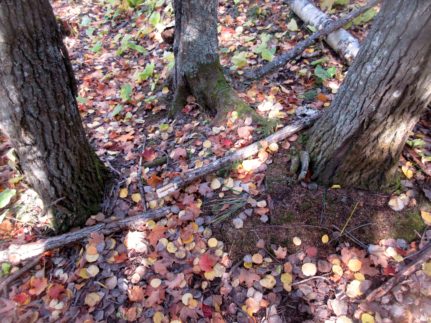By Wolf Ridge Naturalist
overcast, calm, 29°F
The winds that played music for the dancing aspens proved too much for others in the forest.

Last week, winds rocked the ridge like I have never seen. Trails that provided safe and clear passage through the storm one minute were barricaded by fallen trees the next. The stillness today makes it seem as though the forest is holding its breath, unsure if the intruder has left the house.
On the walk down to the mandala, countless trees lay strewn on the ground in various stages of decomposition. Some were ripped from their roots, their vigor no match for the wind, and others stood dead for years before toppling to the floor. As their life in the sky ends, their life on the ground begins. The downed tree that has long been in the mandala now feeds an array of colorful fungi.
The winds brought a fresh arrival and new life to the ground. A wrist-thick, telephone pole long, branchless tree lays across the center, making an “X” with the smaller, fungi-hosting resident.
Disturbance, that is what scientists call tree falls, fires, and landslides, as well as outbreaks of pathogens, insects, and fungi.
A disturbance is an event that alters the composition of an ecosystem. All ecosystems experience disturbances, but the type, frequency, and distribution vary by location. In the coniferous forests of Minnesota, regular fires serve to keep the understory foliage at bay while windstorms serve to open gaps for new trees to mature to reproduction.

A disturbance, whether it is a fire or a windblown tree, often allows for an increase in diversity. When a mature tree falls, there is a rush of light to the forest floor where there used to be shade, and a corresponding arms race from all of the seedlings to catch the sun’s rays. Many small trees will live years of their lives growing no more than head tall, waiting for a gap in the canopy to rise into. Many more trees that couldn’t grow quick enough, or were born three feet to the left of the perfect spot, will never reach the canopy. The baby balsam fir trees in the mandala are playing the lottery, hoping for a disturbance.
At the mandala, the tree that fell was dead for years while it was standing. It held no branches or leaves and created no shade. When it fell, there was no picturesque beam of light to warm the forest floor, and no gap for the seedlings to take advantage of. The baby balsam firs are still waiting.
Disturbance: interruption, breakdown, disruption.
When Obi-wan sensed a “disturbance in the force,” he felt something sinister afoot. However, natural disturbances are anything but sinister; they engender diversity. They kick the dominating species in the shins and allow the struggling ones to take root, ensuring strong cooperation and competition for resources.
Scientific definitions of disturbances often include anthropogenic forces such as logging, pollution, and warfare. That is not a “disturbance in the forest,” but devastation. Such large-scale, impactful changes wipe out entire populations and leave physical and ecological gaps, which, due to our ability to travel across the globe, are often filled by invasive species. While natural disturbances regimes make an ecosystem more robust, human disturbances destabilize natural systems and leave them vulnerable to collapse.
This series is inspired by David G. Haskell’s The Forest Unseen. Haskell visits a one-square meter patch of forest (the mandala) almost daily for one year to tell the story of the forest changing through the seasons. Haskell uses the term mandala, referencing the Buddhist geometric figure symbolizing the universe, to refer to the small forest patch he watches. I’ll be visiting the same spot in the forest a few times a week, periodically writing about the experience, and connecting the stories I see unfolding to larger themes of biology.

